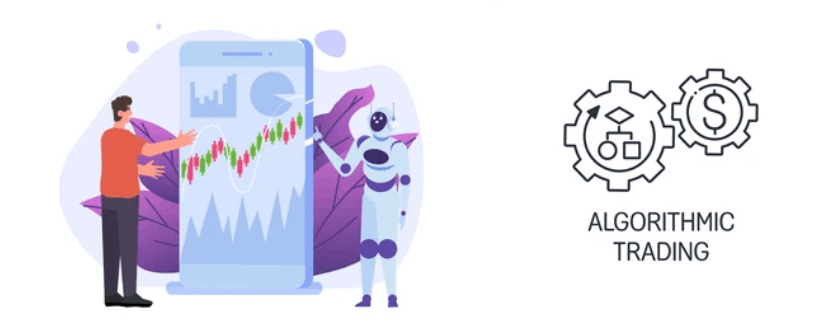Advantages and Types of Algorithmic Trading, Disadvantages to Consider
Algorithmic trading is the process of executing buy or sell orders in financial markets using computers following pre-defined rules. An algorithm is a set of instructions that outlines the steps to be followed in solving a problem. In algorithmic trading, these algorithms analyze market data to automatically make buy or sell decisions.
Algorithmic trading has several advantages over traditional manual trading. Some of these advantages include:
- Speed: Algorithmic trading can make trades in seconds without human intervention. This is a major advantage, especially in highly liquid markets.
- Data analysis: Algorithms can analyze market data much faster and more efficiently than the human brain. This makes it possible to make more accurate and profitable trading decisions.
- Objectivity: Algorithms are not affected by human emotions. This makes it possible to make more consistent and risk-reduced trades.
Types of Algorithmic Trading
Algorithmic trading can be classified according to different strategies. Some of these strategies include:
- Technical analysis: Technical analysis attempts to predict future price movements by analyzing past price movements. In algorithmic trading, technical analysis is a common strategy used to make buy or sell decisions.
- Fundamental analysis: Fundamental analysis attempts to determine the value of a company by analyzing its financial statements and other fundamental information. In algorithmic trading, fundamental analysis is a common strategy used in long-term investment strategies.
- Price action: Price action attempts to predict future price movements by analyzing the past behavior of a financial instrument's price. In algorithmic trading, price action is a common strategy used in short-term investment strategies.
Advantages and Disadvantages of Algorithmic Trading
Algorithmic trading has several advantages. Some of these advantages include:
- Speed: Algorithmic trading can make trades in seconds without human intervention. This is a major advantage, especially in highly liquid markets.
- Data analysis: Algorithms can analyze market data much faster and more efficiently than the human brain. This makes it possible to make more accurate and profitable trading decisions.
- Objectivity: Algorithms are not affected by human emotions. This makes it possible to make more consistent and risk-reduced trades.
However, algorithmic trading also has some disadvantages. Some of these disadvantages include:
- High cost: Algorithmic trading requires specialized software and hardware. This means a higher cost than traditional manual trading.
- Complexity: Algorithmic trading requires complex technical knowledge. This can be a barrier for beginners to algorithmic trading.
- Risk: Algorithmic trading carries a higher risk than traditional manual trading. This is due to the fact that algorithms can make mistakes and lead to large losses.
The Future of Algorithmic Trading
Algorithmic trading is becoming increasingly common in financial markets. This is due to the fact that markets are becoming more complex and competitive. Algorithmic trading helps investors to compete in these challenging market conditions.
The future of algorithmic trading will be shaped by the development of technologies such as artificial intelligence and machine learning. The development of these technologies will make algorithmic trading more efficient and profitable.
Getting Started with Algorithmic Trading
Investors who want to get started with algorithmic trading first need to understand the markets and algorithmic trading strategies well. They also need specialized software and hardware for algorithmic trading.
There are many different ways to get started with algorithmic trading. Investors can get help from institutions or consultants that offer algorithmic trading education. There are also many companies that provide algorithmic trading software and hardware.
Algorithmic trading can be a profitable investment tool for experienced investors. However, it is important to understand the risks and requirements before starting algorithmic trading.
Resources for Getting Started with Algorithmic Trading
The following resources may be helpful for investors who want to get started with algorithmic trading:
- Books:
- "Algorithmic Trading: Winning Strategies and Techniques for Automated Trading" by Ernie Chan
- "Algorithmic Trading: A Beginner's Guide" by Michael Halls-Moore
- "Algorithmic Trading: A Practical Guide to Automated Trading Strategies" by Kevin Davey
- Websites:
- Quantitative Finance
- Quantitative Trading
- Algorithmic Trading Masterclass
- Courses:
- Udemy
- Coursera
- edX
These resources will help you learn the basics of algorithmic trading and its strategies. They may also help you learn about algorithmic trading software and hardware.
Before you start algorithmic trading, it is important to understand the risks and requirements. Algorithmic trading carries a higher risk than traditional manual trading. This is due to the fact that algorithms can make mistakes and lead to large losses.
To get started with algorithmic trading, you can follow these steps:
- Understand the markets and algorithmic trading strategies well.
- Determine if you need algorithmic trading software and hardware.
- Get algorithmic trading education or get help from a consultant.
- Test and optimize your algorithmic trading strategies.
Algorithmic trading can be a profitable investment tool for experienced investors. However, it is important to understand the risks and requirements before you start algorithmic trading.




































